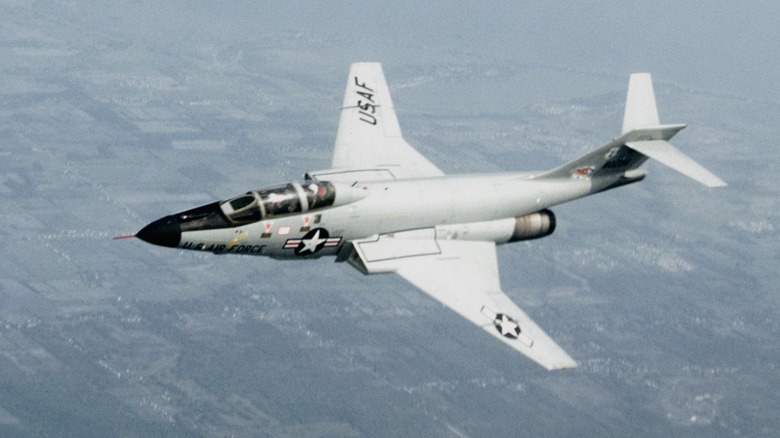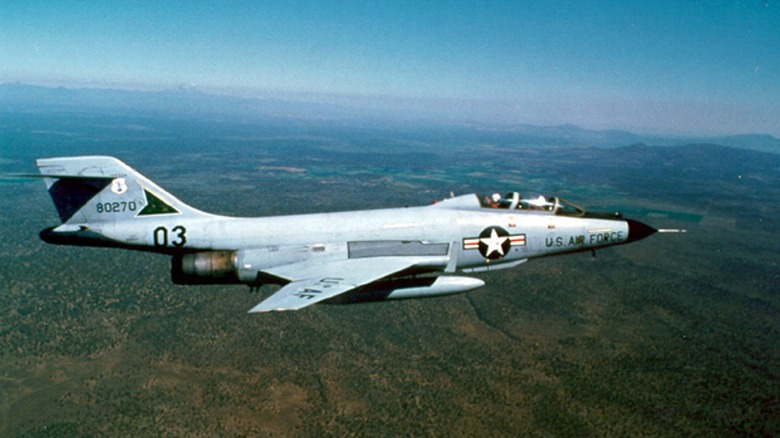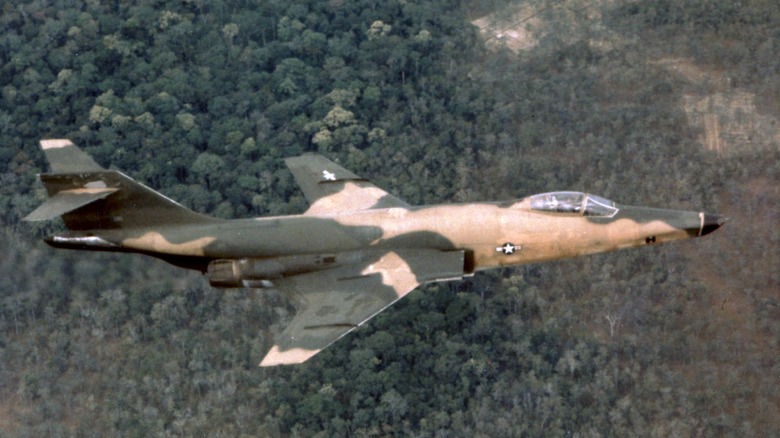Why Did The US Retire The F-101 Voodoo Fighter Jet, And What Replaced It?
The United States Air Force has flown all kinds of fighters over the years, and many are well-known. Movies like "Iron Eagle" and "Top Gun" show off impressive examples like the F-14 Tomcat, F-16 Fighting Falcon, the F/A-18 Super Hornet, and many others. But one aircraft the public likely doesn't know much about is the F-101 Voodoo, which started flying all the way back in the 1950s.
Development for the F-101 began in the 1940s, intended to function as a long-range strategic penetration escort for bombers like the B-52 Stratofortress, while working off the XF-88 penetration fighter program. However, that wasn't its only role — it was used for a variety of purposes, including photographic recon and intelligence, surveillance, and reconnaissance (ISR). By the time the F-101 was ready to enter the inventory, the U.S. Air Force needed an interceptor, and the F-101B Voodoo was picked for that purpose. The new jet was finally introduced to the Air Force's inventory in May 1957.
Ultimately, the F-101 served its purpose, but it wasn't as refined as the Air Force wanted. Instead, it served as a sort of evolutionary link between the earliest U.S. jet designs and the F-4 Phantom II, which replaced the F-101 as the Air Force's primary interceptor. The multirole aspect of the F-101's service record ended, but they remained in use for decades, retiring from U.S. service in 1982 and the Royal Canadian Air Force in 1984.
[Featured image by U.S. Air Force via Wikimedia Commons | Cropped and scaled | Public Domain]
The F-101 Voodoo
The F-101 Voodoo went through numerous design changes before it rolled off the assembly line. Because it was eyed for multiple roles, finalizing its design took some time, resulting in three primary American variants, the F-101A, B, and C. The aircraft was fitted with two Pratt & Whitney J57-P-55 engines, each capable of delivering 16,900 pounds of thrust with their afterburners engaged. These gave the F-101 a maximum speed of Mach 1.43 (1,095 mph).
The standard cruising speed was considerably slower, though still quite fast at 545 mph. The F-101 had a maximum ceiling of 52,100 feet, and at its maximum weight, it came in at 52,400 pounds. In terms of armament, the Air Force crammed what they could into the fuselage, resulting in the carrying of two AIR-2A rockets and two AIM-4 guided missiles. The jet also carried four 20mm M39 autocannons. Additionally, the F-101C could carry and deploy a Mk. 28 or Mk. 43 thermonuclear bomb.
The F-101 was used by the Republic of China Air Force and the Royal Canadian Air Force, as well as the Air National Guard. Other modifications were made to the aircraft over the years, resulting in numerous variants up to the letter H. Throughout the course of their production, 785 Voodoos rolled off assembly lines, and they had a decent operational history, with only 33 being lost during the Vietnam War, which comes out to a loss of 4.2% to combat operations, making it one of the most powerful American jets to serve during the Vietnam War.
It was time for a replacement
The F-101 Voodoo's strange path to production resulted in several variants designed for different purposes. In many ways, the U.S. had still been trying to work out the role of a multirole fighter and interceptor, as they weren't a big part of World War II air combat, when the invention of jet engines introduced a great deal more capability, speed, and maneuverability to the skies. The F-101 was ready to meet that challenge.
However, even when the F-101 was just getting started, plans were already underway to produce a purpose-built interceptor fighter-bomber. That plan resulted in the creation of the F-4 Phantom II, inarguably a more impressive aircraft. The F-4 carried more ordnance and was much faster, reaching a maximum speed of Mach 2.23 (1,711 mph) and a greater ceiling of almost 60,000 feet. The F-4 incorporated more advanced technology as well, making it the superior fighter.
Once production was fully underway, the U.S. Air Force adopted the F-4, relegating the F-101 to training and other similar missions. The F-101 had served its purpose, instructing on the various lessons learned in fielding a fighter-bomber interceptor aircraft. This helped with the design of the F-101's replacement, and the F-4 went on to serve for decades in the U.S., Germany, Japan, and South Korea, which finally retired the F-4 in 2024.


